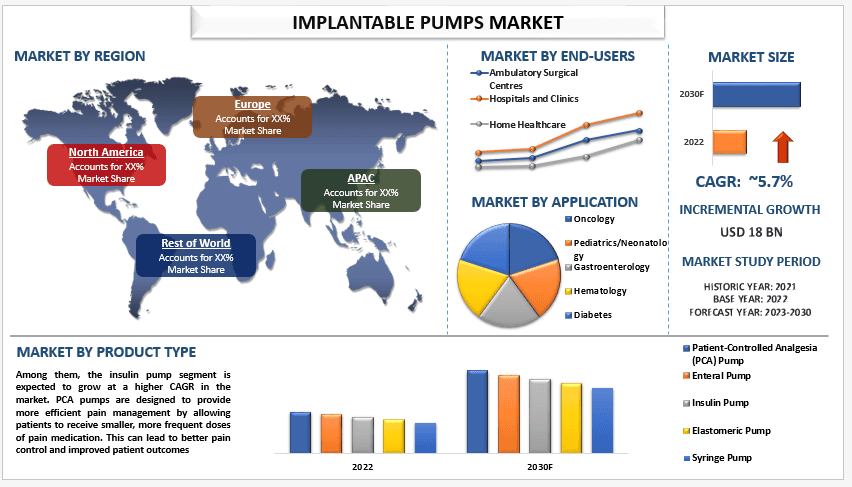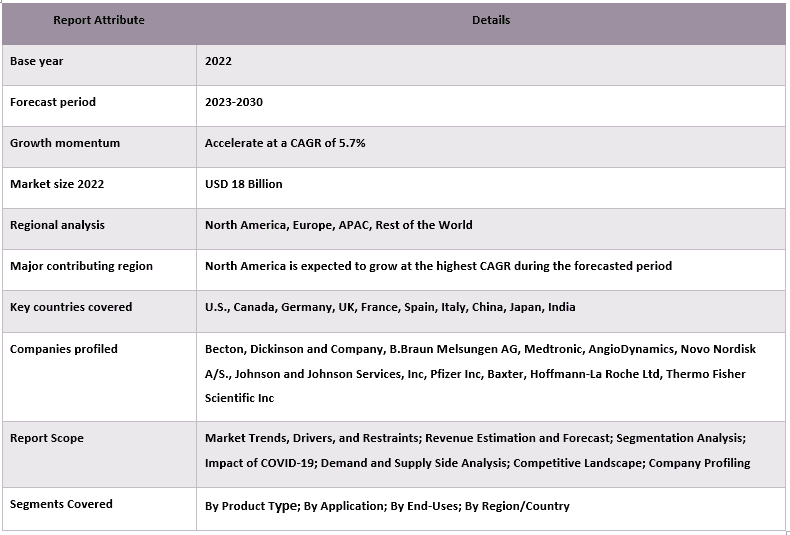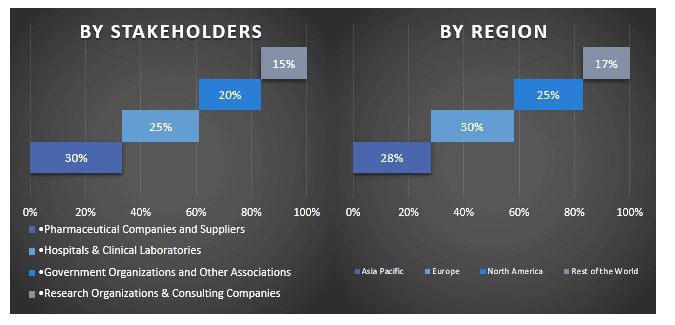- الرئيسية
- معلومات عنا
- صناعة
- الخدمات
- قراءة
- اتصل بنا
سوق المضخات القابلة للزرع: التحليل الحالي والتوقعات (2023-2030)
التركيز على نوع المنتج (مضخة تسكين الألم التي يسيطر عليها المريض (PCA)، ومضخة معوية، ومضخة أنسولين، ومضخة مرنة، ومضخة حقن)؛ والتطبيق (علم الأورام، طب الأطفال/حديثي الولادة، أمراض الجهاز الهضمي، أمراض الدم، مرض السكري)؛ والمستخدمون النهائيون (المستشفيات والعيادات، ومراكز الجراحة المتنقلة، والرعاية الصحية المنزلية)؛ والمنطقة/البلد

بلغت قيمة سوق المضخات القابلة للزرع 18 مليار دولار أمريكي في عام 2022 ومن المتوقع أن ينمو بمعدل نمو سنوي مركب قدره 5.7٪ من 2023-2030. المضخات القابلة للزرع هي أجهزة طبية مصممة لتوصيل كمية محكومة من الأدوية أو السوائل مباشرة إلى الجسم. تُزرع هذه المضخات عادةً تحت الجلد وتستخدم لأغراض علاجية مختلفة، مثل إدارة الألم والعلاج الكيميائي وتوصيل الأنسولين لمرض السكري. يمكن أن يُعزى الطلب المتزايد على المضخات القابلة للزرع إلى الزيادة في انتشار الأمراض المزمنة مثل أمراض القلب والأوعية الدموية والسرطان وما إلى ذلك، وهي العوامل الرئيسية التي تعزز التبني في جميع أنحاء العالم. على سبيل المثال، وفقًا لمراكز السيطرة على الأمراض والوقاية منها (CDC)، يموت شخص واحد كل 33 ثانية في الولايات المتحدة بسبب أمراض القلب والأوعية الدموية. توفي حوالي 695000 شخص في الولايات المتحدة بسبب أمراض القلب في عام 2021 - أي 1 من كل 5 وفيات. علاوة على ذلك، فإن التطورات المستمرة في التكنولوجيا، بما في ذلك التصغير وتحسين عمر البطارية وقابلية البرمجة المحسنة، يمكن أن تجعل هذه الأجهزة أكثر كفاءة وسهولة في الاستخدام، مما يوسع تطبيقاتها، وقد كان هذا دافعًا رئيسيًا. علاوة على ذلك، تلعب المضخات القابلة للزرع دورًا حاسمًا في علم الأورام للكشف عن الأورام وتقييمها. وقد أدى الارتفاع في حالات السرطان في جميع أنحاء العالم إلى زيادة الطلب على إجراءات المضخات القابلة للزرع. في عام 2021، ظل السرطان مصدر قلق كبير في مجال الرعاية الصحية.
بعض اللاعبين الرئيسيين العاملين في السوق هم Becton, Dickinson and Company و B.Braun Melsungen AG و Medtronic و AngioDynamics و Novo Nordisk A/S. و Johnson and Johnson Services, Inc و Pfizer Inc و Baxter و Hoffmann-La Roche Ltd و Thermo Fisher Scientific Inc. وقد قام هؤلاء اللاعبون بالعديد من عمليات الاندماج والاستحواذ بالإضافة إلى الشراكات لتسهيل تزويد العملاء بالمنتجات / التقنيات المبتكرة ذات التقنية العالية.
الرؤى المقدمة في التقرير
"من بين أنواع المنتجات، استحوذ قطاع مضخات تسكين الألم التي يتحكم بها المريض (pca) على حصة كبيرة من السوق في عام 2022."
استنادًا إلى نوع المنتج، تم تصنيف السوق إلى مضخة تسكين الألم التي يتحكم بها المريض (pca)، ومضخة معوية، ومضخة الأنسولين، ومضخة مرنة، ومضخة الحقن. من بينها، من المتوقع أن ينمو قطاع مضخات الأنسولين بمعدل نمو سنوي مركب أعلى في السوق. تم تصميم مضخات PCA لتوفير إدارة أكثر كفاءة للألم من خلال السماح للمرضى بتلقي جرعات أصغر وأكثر تكرارًا من أدوية الألم. يمكن أن يؤدي ذلك إلى تحكم أفضل في الألم وتحسين نتائج المرضى.
"من بين التطبيقات، حقق قطاع الأورام معدل نمو سنوي مركب أعلى في السوق في عام 2022."
استنادًا إلى التطبيق، تم تصنيف السوق إلى الأورام وطب الأطفال / حديثي الولادة وأمراض الجهاز الهضمي وأمراض الدم والسكري. من بينها، من المتوقع أن ينمو قطاع الأورام بمعدل نمو سنوي مركب أعلى في السوق. غالبًا ما تستخدم المضخات القابلة للزرع لإدارة الألم لدى مرضى السرطان. يمكن لهذه الأجهزة توصيل جرعات محكومة ومستمرة من أدوية الألم مباشرة إلى المنطقة المصابة، مما يوفر تخفيفًا أكثر استهدافًا. علاوة على ذلك، تم تصميم بعض المضخات القابلة للزرع لتوصيل الأدوية داخل القراب، والتي يمكن أن تكون حاسمة في توصيل أدوية العلاج الكيميائي مباشرة إلى السائل النخاعي حول الحبل الشوكي. يمكن أن يكون هذا النهج المستهدف أكثر فعالية في علاج أنواع معينة من السرطانات.
"هيمنت أمريكا الشمالية على سوق المضخات القابلة للزرع في عام 2022."
من المتوقع أن يستمر سوق المضخات القابلة للزرع في أمريكا الشمالية في النمو في السنوات القادمة، مدفوعًا بالزيادة في انتشار السرطان وزيادة الوعي بالمضخات القابلة للزرع بين متخصصي الرعاية الصحية وعامة السكان، وتطوير تقنيات التصوير المتقدمة والزيادة في خيارات العلاج. على سبيل المثال، في عام 2020، وفقًا لجمعية السرطان الأمريكية، يعد السرطان ثاني أكثر أسباب الوفاة شيوعًا في الولايات المتحدة، ولا يتجاوزه سوى أمراض القلب. من المتوقع حدوث حوالي 609360 حالة وفاة بسبب السرطان في الولايات المتحدة في عام 2022، وهو ما يمثل حوالي 1670 حالة وفاة يوميًا.
تغطية تقرير سوق المضخات القابلة للزرع

أسباب شراء هذا التقرير:
- تتضمن الدراسة تحليل حجم السوق والتنبؤ به تم التحقق منه من قبل خبراء الصناعة الرئيسيين الموثوق بهم.
- يقدم التقرير مراجعة سريعة للأداء العام للصناعة في لمحة.
- يغطي التقرير تحليلًا متعمقًا لأقران الصناعة البارزين مع التركيز الأساسي على البيانات المالية الرئيسية للأعمال ومحافظ المنتجات واستراتيجيات التوسع والتطورات الأخيرة.
- فحص تفصيلي للدوافع والقيود والاتجاهات الرئيسية والفرص السائدة في الصناعة.
- تغطي الدراسة بشكل شامل السوق عبر قطاعات مختلفة.
- تحليل متعمق على المستوى الإقليمي للصناعة.
خيارات التخصيص:
يمكن تخصيص سوق المضخات القابلة للزرع العالمي بشكل أكبر وفقًا للمتطلبات أو أي قطاع سوق آخر. إلى جانب ذلك، تتفهم UMI أن لديك احتياجات عمل خاصة بك، لذا لا تتردد في التواصل معنا للحصول على تقرير يناسب متطلباتك تمامًا.
جدول المحتويات
منهجية البحث لتحليل سوق المضخات القابلة للزرع (2022-2030)
كان تحليل السوق التاريخي وتقدير السوق الحالي والتنبؤ بالسوق المستقبلي لسوق المضخات القابلة للزرع العالمي هي الخطوات الرئيسية الثلاث التي تم اتخاذها لإنشاء وتحليل اعتماد المضخات القابلة للزرع في المناطق الرئيسية على مستوى العالم. تم إجراء بحث ثانوي شامل لجمع أرقام السوق التاريخية وتقدير حجم السوق الحالي. ثانيًا، للتحقق من صحة هذه الرؤى، تم أخذ العديد من النتائج والافتراضات في الاعتبار. علاوة على ذلك، تم أيضًا إجراء مقابلات أولية شاملة مع خبراء الصناعة عبر سلسلة القيمة لسوق المضخات القابلة للزرع العالمي. بعد افتراض أرقام السوق والتحقق من صحتها من خلال المقابلات الأولية، استخدمنا نهجًا من أعلى إلى أسفل / من أسفل إلى أعلى للتنبؤ بحجم السوق الكامل. بعد ذلك، تم اعتماد طرق تقسيم السوق وتثليث البيانات لتقدير وتحليل حجم السوق للقطاعات والقطاعات الفرعية للصناعة ذات الصلة. تم شرح المنهجية التفصيلية أدناه:
تحليل حجم السوق التاريخي
الخطوة 1: دراسة متعمقة للمصادر الثانوية:
تم إجراء دراسة ثانوية تفصيلية للحصول على حجم السوق التاريخي لسوق المضخات القابلة للزرع من خلال المصادر الداخلية للشركة مثل التقارير السنوية والبيانات المالية، وعروض الأداء، والنشرات الصحفية، وما إلى ذلك، والمصادر الخارجية بما في ذلك المجلات والأخبار والمقالات والمنشورات الحكومية ومنشورات المنافسين وتقارير القطاعات وقاعدة بيانات الطرف الثالث والمنشورات الموثوقة الأخرى.
الخطوة 2: تجزئة السوق:
بعد الحصول على حجم السوق التاريخي لسوق المضخات القابلة للزرع، أجرينا تحليلًا ثانويًا تفصيليًا لجمع رؤى السوق التاريخية وحصة القطاعات والقطاعات الفرعية المختلفة للمناطق الرئيسية. يتم تضمين القطاعات الرئيسية في التقرير كنوع المنتج والتطبيق والمستخدمين النهائيين. تم إجراء المزيد من التحليلات على مستوى الدولة لتقييم الاعتماد الكلي لنماذج الاختبار في تلك المنطقة.
الخطوة 3: تحليل العوامل:
بعد الحصول على حجم السوق التاريخي للقطاعات والقطاعات الفرعية المختلفة، أجرينا تحليل عوامل مفصل لتقدير حجم السوق الحالي لسوق المضخات القابلة للزرع. علاوة على ذلك، أجرينا تحليلًا للعوامل باستخدام متغيرات تابعة ومستقلة مثل نوع المنتج والتطبيق والمستخدمين النهائيين لسوق المضخات القابلة للزرع. تم إجراء تحليل شامل لسيناريوهات الطلب والعرض مع الأخذ في الاعتبار أهم الشراكات وعمليات الاندماج والاستحواذ وتوسيع الأعمال وإطلاق المنتجات في قطاع سوق المضخات القابلة للزرع في جميع أنحاء العالم.
تقدير حجم السوق الحالي والتوقعات
تحديد حجم السوق الحالي: بناءً على رؤى قابلة للتنفيذ من الخطوات الثلاث المذكورة أعلاه، توصلنا إلى حجم السوق الحالي واللاعبين الرئيسيين في سوق المضخات القابلة للزرع العالمي والحصص السوقية للقطاعات. تم تحديد جميع حصص النسبة المئوية المطلوبة وتقسيمات السوق باستخدام النهج الثانوي المذكور أعلاه وتم التحقق منها من خلال المقابلات الأولية.
التقدير والتنبؤ: لتقدير السوق والتنبؤ به، تم تخصيص أوزان لعوامل مختلفة بما في ذلك المحركات والاتجاهات والقيود والفرص المتاحة لأصحاب المصلحة. بعد تحليل هذه العوامل، تم تطبيق تقنيات التنبؤ ذات الصلة، أي النهج من أعلى إلى أسفل / من أسفل إلى أعلى، للتوصل إلى توقعات السوق لعام 2030 للقطاعات والقطاعات الفرعية المختلفة عبر الأسواق الرئيسية على مستوى العالم. تتضمن منهجية البحث المعتمدة لتقدير حجم السوق ما يلي:
- حجم سوق الصناعة، من حيث الإيرادات (بالدولار الأمريكي) ومعدل اعتماد سوق المضخات القابلة للزرع عبر الأسواق الرئيسية محليًا
- جميع الحصص والتقسيمات والتقسيمات المئوية لقطاعات السوق والقطاعات الفرعية
- اللاعبون الرئيسيون في سوق المضخات القابلة للزرع العالمي من حيث المنتجات المعروضة. أيضًا، استراتيجيات النمو التي يتبناها هؤلاء اللاعبون للتنافس في السوق سريع النمو
التحقق من صحة حجم السوق والحصة السوقية
البحث الأولي: تم إجراء مقابلات متعمقة مع قادة الرأي الرئيسيين (KOLs) بما في ذلك كبار المديرين التنفيذيين (CXO / VPs، ورئيس المبيعات، ورئيس التسويق، والرئيس التشغيلي، والرئيس الإقليمي، ورئيس الدولة، وما إلى ذلك) في جميع المناطق الرئيسية. ثم تم تلخيص نتائج البحث الأولي وإجراء تحليل إحصائي لإثبات الفرضية المذكورة. تم دمج المدخلات من البحث الأولي مع النتائج الثانوية، وبالتالي تحويل المعلومات إلى رؤى قابلة للتنفيذ.
تقسيم المشاركين الأساسيين في مناطق مختلفة

هندسة السوق
تم استخدام تقنية تثليث البيانات لإكمال تقدير السوق الإجمالي والتوصل إلى أرقام إحصائية دقيقة لكل قطاع وقطاع فرعي من سوق المضخات القابلة للزرع العالمي. تم تقسيم البيانات إلى عدة قطاعات وقطاعات فرعية بعد دراسة مختلف المعلمات والاتجاهات في مجالات نوع المنتج والتطبيق والمستخدمين النهائيين في سوق المضخات القابلة للزرع العالمي.
الهدف الرئيسي من دراسة سوق المضخات القابلة للزرع العالمي
تم تحديد اتجاهات السوق الحالية والمستقبلية لسوق المضخات القابلة للزرع العالمي في الدراسة. يمكن للمستثمرين اكتساب رؤى استراتيجية لترسيخ تقديرهم للاستثمارات على التحليل النوعي والكمي الذي تم إجراؤه في الدراسة. حددت اتجاهات السوق الحالية والمستقبلية الجاذبية الإجمالية للسوق على المستوى الإقليمي، مما يوفر منصة للمشارك الصناعي لاستغلال السوق غير المستغلة للاستفادة من ميزة المحرك الأول. تشمل الأهداف الكمية الأخرى للدراسات ما يلي:
- تحليل حجم السوق الحالي والمتوقع لسوق المضخات القابلة للزرع من حيث القيمة (بالدولار الأمريكي). أيضًا، تحليل حجم السوق الحالي والمتوقع للقطاعات والقطاعات الفرعية المختلفة
- تشمل القطاعات في الدراسة مجالات نوع المنتج والتطبيق والمستخدمين النهائيين
- تحديد وتحليل الإطار التنظيمي لصناعة المضخات القابلة للزرع
- تحليل سلسلة القيمة المتضمنة في وجود وسطاء مختلفين، جنبًا إلى جنب مع تحليل سلوكيات العملاء والمنافسين في الصناعة
- تحليل حجم السوق الحالي والمتوقع لسوق المضخات القابلة للزرع للمنطقة الرئيسية
- تشمل الدول الرئيسية في المناطق التي تمت دراستها في التقرير آسيا والمحيط الهادئ وأوروبا وأمريكا الشمالية وبقية دول العالم
- ملفات تعريف الشركة لسوق المضخات القابلة للزرع واستراتيجيات النمو التي يتبناها اللاعبون في السوق للحفاظ على قدرتهم على المنافسة في السوق سريع النمو
- تحليل متعمق على المستوى الإقليمي للصناعة
الأسئلة الشائعة الأسئلة الشائعة
س1: ما هو حجم السوق الحالي وإمكانات النمو لسوق المضخات القابلة للزرع العالمي؟
س2: ما هي العوامل الدافعة لنمو سوق المضخات القابلة للزرع العالمي؟
س3: أي قطاع يمتلك الحصة الأكبر في سوق المضخات القابلة للزرع العالمي حسب نوع المنتج؟
س4: ما هي التقنيات والاتجاهات الناشئة في سوق المضخات القابلة للزرع العالمي؟
س5: أي منطقة ستسيطر على سوق المضخات القابلة للزرع العالمي؟
س6: من هم اللاعبون الرئيسيون العاملون في السوق العالمية لمضخات الزراعة؟
ذات صلة التقارير
العملاء الذين اشتروا هذا المنتج اشتروا أيضًا










